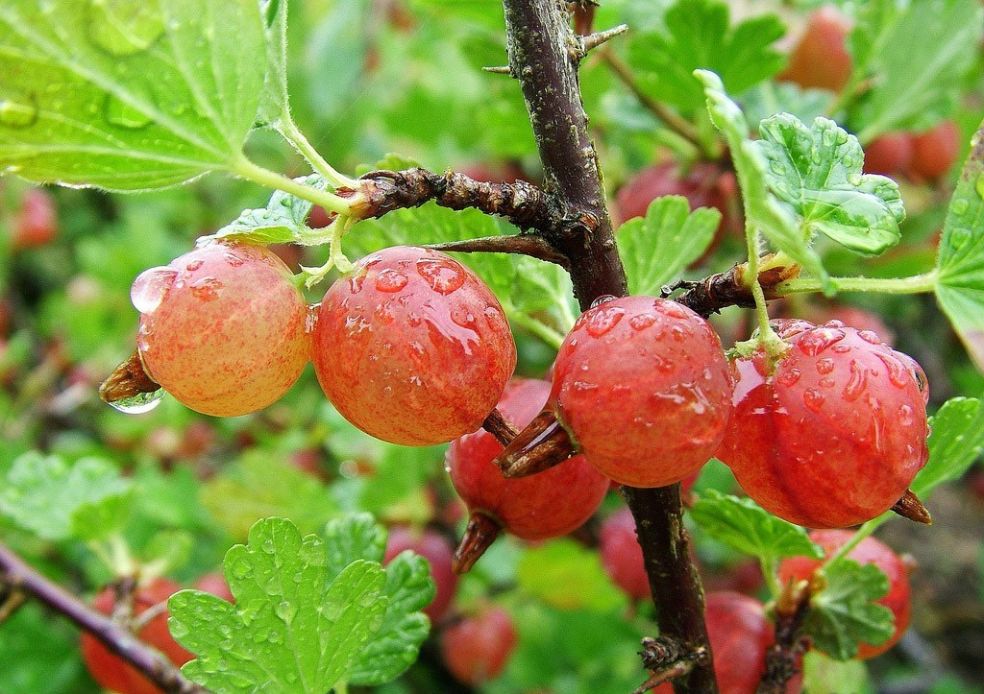Common gooseberry - either European or rejected
Content:
The gooseberry is often referred to as a northern grape due to its physical resemblance to the latter. This is where their common features end, since in fact the gooseberry belongs to the Gooseberry family, the currant is its closest relative.
Everything about gooseberries: variety description
In ancient times, people did not know what a gooseberry was. The first description was given by the French physician J. Raoul almost 500 years ago. From his works it follows that in his era, unripe gooseberries were used to make sauces and soups, and ripe gooseberries were consumed raw. From the doctor's notes, you can learn that gooseberry is not only a berry used for food, but also a rather popular plant for decorating gardens.
Subsequently, the gooseberry was introduced to England, where, thanks to the humid climate, the size of its fruit almost quadrupled over the next 100 years. The plant became so popular on the island that by the beginning of the 17th century. almost all cultivated berry varieties were native to England.
In Russia, gooseberries have also been known for a very long time. The first mention of it appeared in the 11th century. But the greatest peak of popularity came in the 19th century, when large-fruited varieties were brought from England to Russia, which subsequently supplanted the local ones.
Botanical characteristic
The very first question on botanical classification: is a gooseberry a berry or a fruit? Previously, the plant was considered a fruit, but after a careful study of the fruit, it began to be attributed to the berry family. Reproduction of this fruit crop occurs by germination of seeds that have fallen to the ground along with the dried fruit. And this method is typical for berries.
Even children know what a gooseberry looks like, but it is worth considering its characteristics in more detail. This is a shrub that reaches a height of 1.5 m, but there are also undersized specimens that grow to a maximum of half a meter. The diameter of the bush is always equal to its height. The root system develops throughout life and basal shoots are formed on it. After 2-3 years, they turn into real branches on which berries begin to grow.
The quality of the productivity of the stems depends on their location. The central ones, due to the fact that they grow upright and receive little light, bear fruit worse than the lateral branches growing to the sides of the center. The branches of a plant can be with thorns, with few or no thorns at all. The spines can be of different lengths and shapes.
Leaves can differ even on the same bush. They come in a variety of sizes, from small to very large. They have from 3 to 5 tops of a sharp or round shape and light or yellow-green in color. The leaves of the gooseberry are of the five type (five sepals, petals, stamens).
The flower sprouts from the axils of the leaves in a group of 3-4 pcs. It looks most like a bell with five petals. Berries are classified by size into small, medium and large.The largest fruits weigh 4 g.
Distribution area
Initially, gooseberries appeared in Western Europe and North Africa, but now wild varieties have spread to all continents. They grow mainly in mountainous areas, next to rivers and trees. Unlike a domestic plant, they are highly resistant to frost and disease, especially those that live in the northern regions. But at the same time they have a weak resistance to American powdery mildew. Berries of this variety can be smooth or pubescent, of various shapes, colors.
What are gooseberries useful for?
Gooseberries have very beneficial properties. They contain about 12% fructose and glucose, which is well absorbed by the body. The well-known gooseberry acid is due to the content of malic, oxalic and even citric acid, which have a positive effect on digestion. The high content of pectins makes the fruit of the plant an excellent natural remedy for removing radiation. In terms of the content of useful minerals, no other berry can compare with gooseberries.
The benefits of eating gooseberries are very large. Thanks to it, blood circulation and metabolic processes in the body improve, the nervous system and hormonal processes are strengthened.
Since everything about gooseberry and its beneficial properties has been known for a long time, it is widely used in folk medicine. A decoction of the leaves and fruits of the plant helps with kidney disease, anemia, hypovitaminosis. Berries are also useful for children, as they are an excellent fortifying and anti-allergenic agent.
In modern medicine, the berry has also found a use. It is used in the manufacture of various dietary supplements. It is recommended to use it to combat obesity and metabolic disorders. But, despite all the beneficial properties, gooseberries should not be consumed by patients with diabetes.
Care features
In order for the gooseberry to grow properly and also give a bountiful harvest, it needs proper care both in winter and in summer. Following all the recommendations, you can get not only a fruitful plant, but also a beautiful bush that will decorate your summer cottage.
Watering
If it is not enough to water the gooseberries, then it will often hurt, the berries will be large, and the quality of the harvest will decrease. During the formation of new shoots, the bush is watered only in dry weather. Moistening continues during the formation of the berries, but as soon as the fruits ripen, watering stops.
In the fall during the rainy season, the plant is not watered. It should be abundantly moisturized in October so that the root system can prepare for winter.
Fertilization and mulching
The first feeding should be done in the spring. Manure or humus is laid around the bush on the dug earth. When the buds bloom, 50 g of urea is added under the bush. When the plant turns 4 years old, it is fertilized with mineral compounds every spring. After the appearance of the first berries, manure is applied 2-3 times. In the fall, the bush is watered with a solution of potassium nitrate, and closer to winter, before digging, ash or peat is added to the soil.
After the snow melts, the soil becomes very compacted. Therefore, in the spring it is loosened around the bush, but no deeper than 5 cm, so as not to damage the root system. In summer, loosening is done about 4 times, the last time in early August.
Bush supports
Although the gooseberry is a rather unpretentious plant, it happens that it needs additional support. Among gardeners, it is known as a trellis; cucumbers and grapes are grown on such structures. A support may be necessary if the area where the gooseberry is growing is not sufficiently lit. As a result of using it, it will help to get an earlier and more abundant harvest.
Preventive treatment
So that in the summer the plant can delight its owner with abundant flowering, in the spring it should be treated for preventive purposes. But, in order to know how to process the bush, you first need to find out what kind of harm it can threaten. The main diseases and pests that gooseberries can be exposed to are American powdery mildew, anthracnose, septoria, various mites and insects. In any case, treating the plant in spring with copper sulfate will benefit him.
Pruning and preparing for winter
Pruning is an important step in gooseberry development. It is divided into several types:
- formative pruning is necessary to create the correct shape of the bush;
- anti-aging pruning is carried out when the plant becomes more than seven years old, its dry branches and shoots are pruned;
- sanitary pruning - removal of old, dried and diseased branches.
Reproduction
Gooseberries can reproduce in a variety of ways:
- horizontal layering. To do this, young branches are taken, a neat cut is made on top of them, after which they bend to the ground and carefully dig into the holes. When new shoots grow above 10 cm, care begins for them, as for full-fledged plants;
- arcuate layering. Annual branches are laid horizontally in prepared grooves, pinned and covered with soil. The tip of the shoot is brought up in an arc, and in the fall it is separated from the main bush and transplanted;
- division of the bush. Used when transferring to a new location. The bush is cut into pieces, planting is done in pre-prepared holes;
- propagation by cuttings. The transplant technology differs depending on the season. In summer, green cuttings are taken, and lignified in autumn.
Fight disease
All major diseases that can threaten gooseberries are treated by spraying the bush with Bordeaux liquid. If the soil is affected, then it is watered with a solution of copper sulfate. The only disease that is difficult to get rid of is a mosaic (the growth of shoots stops, a mosaic pattern appears on the leaves). The affected bushes are usually disposed of. To protect gooseberries from most pests, branches, leaves and berries are regularly treated with insecticides.
The common gooseberry is a classic of the genre in the horticultural environment. It is in almost every summer cottage, but not everyone knows how to properly care for and reproduce it. The article above will help to replenish knowledge.




















